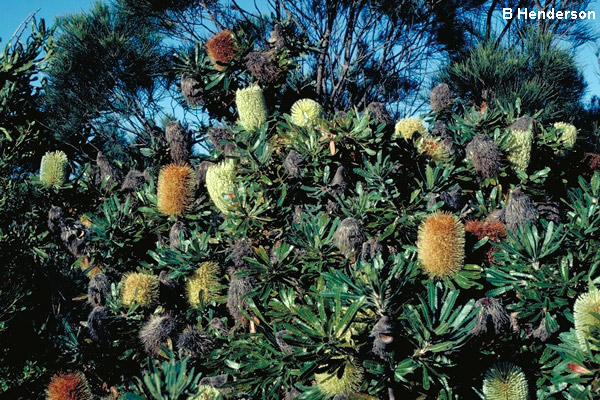
Wallum Banksia
Cas Liber
Known for many years as Banksia serratifolia in New South Wales, the Wallum banksia (Banksia aemula) is a showy autumn flowering shrub or small tree common in coastal sandy soils and heathland from Sydney north to Bundaberg on Australia's east coast. The uncertainty surrounding its scientific name was settled when Alex George ascertained that Salisbury's name (serratifolia) was invalid as there was no specimen and the description was insufficient to diagnose the species.
The Wallum banksia generally a gnarled shrub or small tree which may reach 8 metres in height though usually much smaller.
 |
Wallum banksia
Photo: Barbara Henderson |
Many coastal populations are small indeed, with exposed populations at Wybung Head on the Central Coast of New South Wales only 0.5-1m high. Smaller plants in particular are showy as the terminal green-yellow inflorescences are well- displayed and may reach 20 cm in height and 8 cm in width. Flowering occurs in autumn, from March to June. Old cones have persisting grey flowers, though they are not long enough to hide the often gigantic follicles which may be up to 4 cm in diameter. The green leaves are 3- 22 cm long with saw-shaped (serrate) margins. The thick warty trunk is orange brown-grey in colour.
It is very similar to Banksia serrata but can be distinguished by:
- trunk often has an orange tinge, as opposed to grey.
- adult leaves are narrower than 2cm in diameter.
- inflorescences are generally a brighter green-yellow in colour.
- follicles, which can sometimes (but not always) be very large.
The Wallum banksia is not generally available in general nurseries, though is generally easy to find in specialist native nurseries. It has more appeal horticulturally than Banksia serrata, both in the smaller size of the shrub and generally brighter colour of the blooms. It does, however, seems to be somewhat particular in cultivation - possibly more so than its common cousin. It does best in situations similar to its natural environment, namely a sandy well-drained soil yet access to regular moisture (which can be somewhat tricky in sand), which in nature would be ground water. Extra watering through summer until established is advisable, noting that this may take a couple of years. Unfortunately one has to be patient waiting for flowering as this may take several years in cultivation. It can be pruned hard as it is lignotuberous, and I prefer taking off lower branches to highlight the warty gnarled trunk.
From "Native Plants for New South Wales", the newsletter of the NSW Region of the Australian Plants Society, April 2007.
Australian Plants online - 2008
Association of Societies for Growing Australian Plants
|